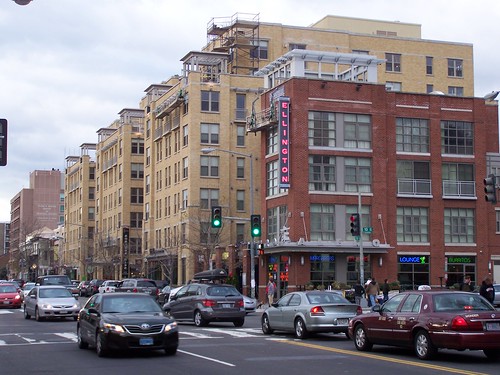More on that "traffic study": DC itself is a best practice example of transit oriented development**
 The Ellington building on the 1300 block of U Street NW is a few steps away from a Metro station exit on the south side of the 1200 block.
The Ellington building on the 1300 block of U Street NW is a few steps away from a Metro station exit on the south side of the 1200 block. I was unimpressed with some of the argumentation (not the argument) on why reducing the number of car parking spaces was justified.
Here's what I wrote.
... on the value of transit oriented development. My objection to this paragraph is more methodological. They focus on Portland, Oregon as a best practice example. I love Portland but it is almost* completely irrelevant to Washington, DC because DC's mode split for sustainable transportation modes (walking, biking, transit) is 50% higher than Portland.
More people use transit or walk in DC than in Portland, although Portland has more residents using bicycling for transportation. DC (and Arlington County) is a far better example of transit oriented development over the past 30 years than is Portland (* although Portland does waterfront development, streetcars, aerial trams, biking, and general quality of life planning better than does DC + they have better coffee shops, the McMenamin Brothers brewpubs, accommodations, and cinemas, and Powell's Bookstore).
So they should have provided information relevant to similar buildings in similar locations in Washington DC, and maybe if they wanted, Montgomery and Arlington Counties, because those counties have similar demographic characteristics to this part of Ward 4.
A better method would have been to take the transit station typology in the WMATA bike and ped access study (summary), and presented information on similar settings elsewhere in the region. According to that study, Takoma is defined as a type of "residential center."
Similarly, WMATA's development and transit utilization study from 2005 finds high rate of transit use in developments located within 1/4 mile and 1/2 mile from the station. If anything, the numbers in DC for transit use are higher today than they were when the study was conducted.
-------
Trans-Formation: Recreating Transit-Oriented Neighborhood Centers in DC: Design Handbook (2002 DC Office of Planning report, now out-of-print)
** Reports notwithstanding, we do make plenty of mistakes. But then Portland probably does too.
Labels: parking and curbside management, transit oriented development



0 Comments:
Post a Comment
<< Home